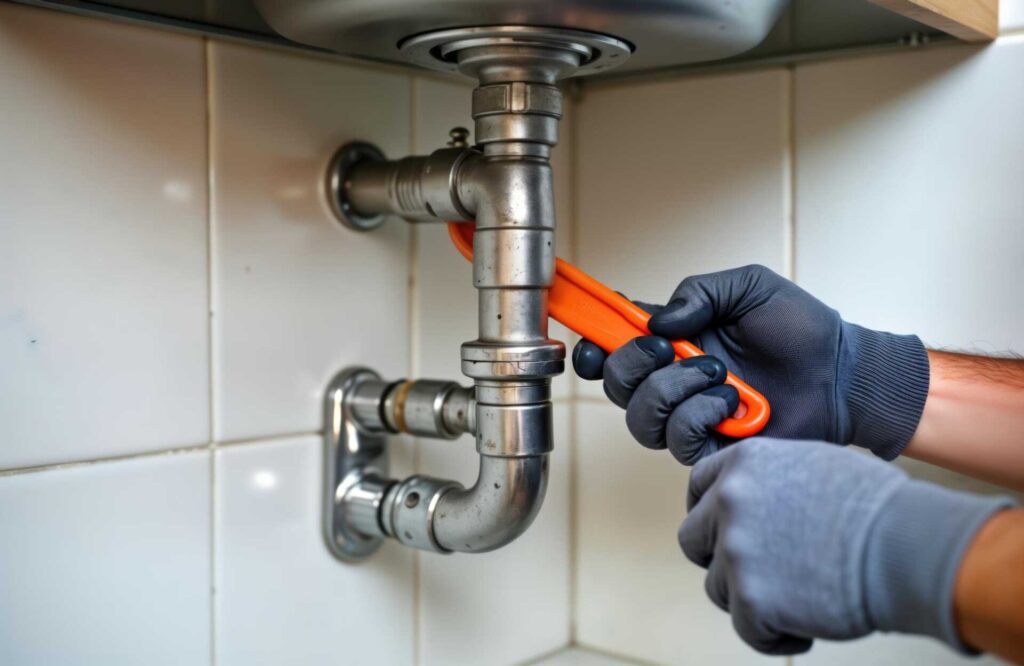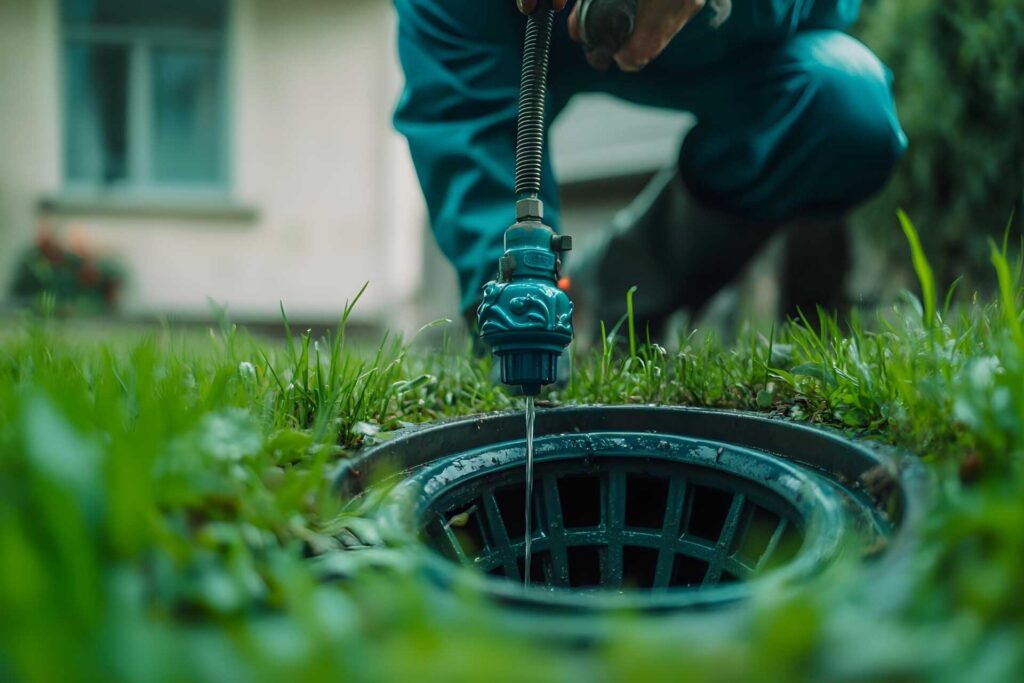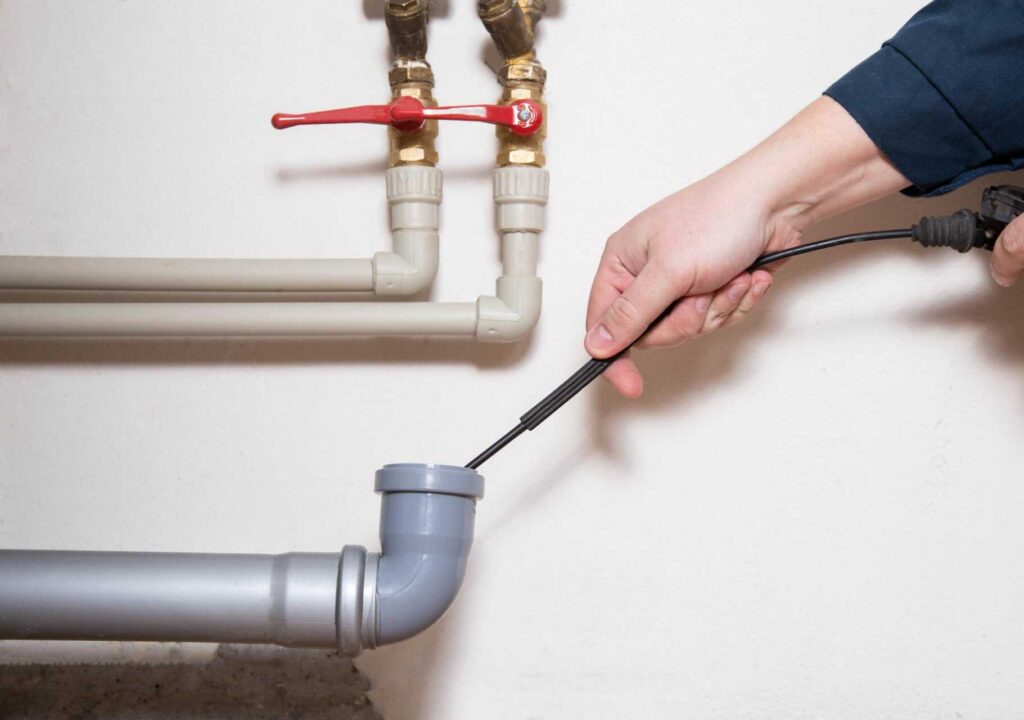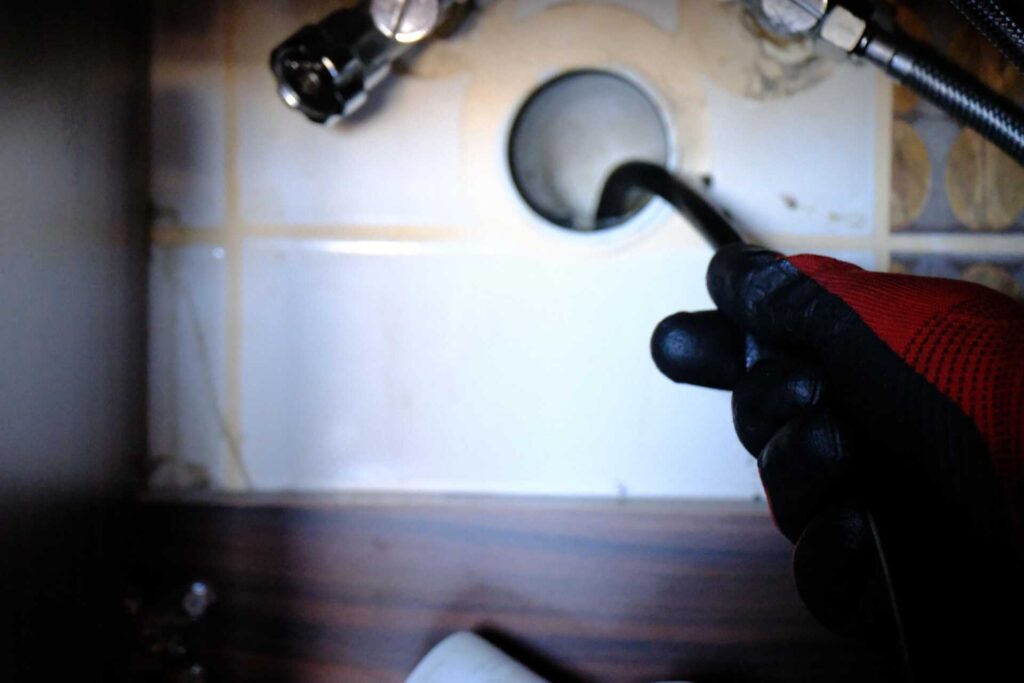
Contents
Like Odysseus traversing treacherous waters, you’ll face intimidating pipe blockages that require strategy and persistence. You might notice slow drainage or hear unsettling gurgling sounds, which signal it’s time to take action. With a few effective techniques at your disposal, you can tackle these issues head-on. But before you grab that plunger or consider chemical cleaners, there are essential steps to follow that could save you time and hassle in the long run. Discovering these tips could mean the difference between a quick fix and a plumbing nightmare.
Key Takeaways
- Identify blockage signs like slow drainage or foul odors to address issues early before they escalate.
- Use a plumber’s snake for resistance detection, and consider video inspection for clear blockage assessment.
- Employ hot water in stages to dissolve grease and debris, allowing intervals for effective heat penetration.
- Consider professional help for persistent issues, as they may indicate damaged pipes or tree root intrusion.
- Implement regular maintenance and educate household members on proper disposal practices to prevent future clogs.
Identify the Blockage Source
How can you effectively identify the source of a pipe blockage? Start by looking for common blockage signs. These might include slow drainage, gurgling sounds, or water backing up in sinks or tubs. Identifying these symptoms early can save you time and frustration.
Next, employ diagnostic tools to pinpoint the issue. A plumber’s snake is a versatile tool that allows you to probe deeper into the pipe system. Insert it into the drain until you encounter resistance, which often indicates the location of the blockage. If you’re dealing with a stubborn clog, consider using a video inspection camera. This tool provides a visual representation of the inside of your pipes and can reveal the nature of the obstruction, whether it’s grease buildup, tree roots, or foreign objects.
Don’t overlook the importance of understanding where the blockage is likely to occur. Familiarize yourself with the layout of your plumbing system. Areas with frequent clogs, such as bends or junctions, are particularly susceptible. Regular maintenance can also help prevent future issues by allowing you to address early blockage signs before they escalate.
Use a Plunger Effectively
A plunger is one of the most effective tools for clearing minor pipe blockages. Using the right plunger type and techniques can make a significant difference in your success. Here’s a quick overview of common plunger types:
| Plunger Type | Best For | Technique |
|---|---|---|
| Cup Plunger | Toilets | Create a tight seal, push down and pull up sharply. |
| Flange Plunger | Toilets and sink drains | Create a tight seal, push down, and pull up sharply. |
| Sink Plunger | Kitchen and bathroom sinks | Use a steady up-and-down motion to create suction. |
To effectively use a plunger, start by ensuring you have the right type. For toilets, a flange plunger works best, while a cup plunger is ideal for sinks. Before you begin, make sure there’s enough water in the bowl or sink to cover the plunger’s rubber cup. This helps create a better seal and suction.
Next, position the plunger over the drain, ensuring a tight fit. Employ quick, forceful thrusts; don’t be afraid to apply pressure. The goal is to create a vacuum that dislodges the blockage. If you don’t see immediate results, try varying your techniques or angles. Patience is key—sometimes it takes a few tries to clear the blockage. With practice, you’ll master these plunger techniques and tackle those pesky clogs like a pro.
Try a Drain Snake
When you encounter stubborn blockages, a drain snake can be an effective tool. There are various types of drain snakes tailored for different applications, and knowing the proper usage techniques is essential for success. Let’s explore how to choose the right drain snake and use it effectively to clear your pipes.
Types of Drain Snakes
Drain snakes are essential tools for clearing stubborn blockages in pipes, and understanding the different types can help you choose the right one for your needs. There are primarily two categories: manual drain snakes and electric drain snakes.
Manual drain snakes, often known as hand-crank snakes, are ideal for minor clogs and smaller pipes. They’re easy to use and provide great control while guiding through bends and turns in your plumbing. You simply feed the snake into the drain and turn the handle to break up or retrieve the blockage.
On the other hand, electric drain snakes are suited for tougher clogs and larger pipes. These powered tools can tackle more significant blockages with greater speed and efficiency. They come with various attachments and augers, allowing you to customize your approach based on the clog’s nature.
When deciding between the two, consider the severity of your blockage and the size of your pipes. Both types can be effective, but knowing their differences ensures you’ll have the right tool at your disposal, making you feel more confident in your plumbing skills.
Proper Usage Techniques
To effectively tackle a blockage, start by selecting the right drain snake for your specific situation. If you’re dealing with small clogs, a hand-crank snake will suffice. For more stubborn blockages, consider a powered drain snake. Before beginning pipe cleaning, verify you’ve got safety gear, like gloves and goggles, to protect yourself.
Insert the snake into the drain slowly, allowing it to navigate through the pipes. When you feel resistance, you’ve likely reached the blockage. Rotate the snake clockwise while pushing it forward. This motion helps break up the clog and can dislodge debris. If you encounter a particularly dense blockage, apply more pressure and continue to twist the snake.
Once the blockage is loosened, carefully pull the snake back out, checking for any debris that may have been removed. Run hot water down the drain to flush away any remaining particles. Regular use of a drain snake can aid in blockage prevention, keeping your pipes clear and functional. Remember, consistent pipe cleaning is key to maintaining a healthy plumbing system and avoiding future headaches. With the right technique, you’ll feel empowered to keep your drains flowing smoothly.
Hot Water Technique
Although many blockages can seem intimidating, the hot water technique offers an effective and straightforward solution. This method harnesses the power of hot water to break down grease, soap scum, and other debris that often cause clogs. By introducing hot water into your pipes, you can utilize its benefits to dissolve stubborn buildups, making it an essential first step in clearing blockages.
To implement this technique, you’ll need to heat water to an effective temperature—ideally, just below boiling. Pouring boiling water directly into the drain can be too harsh on certain plumbing materials, so it’s best to allow the water to cool slightly. Once you’ve reached the right temperature, slowly pour the hot water down the drain in stages. Allowing intervals between each pour gives the heat time to penetrate the blockage effectively.
If you’re dealing with particularly tough clogs, you can repeat this process a few times. Hot water benefits include breaking down blockages and flushing out residual debris that may contribute to future issues. Always remember to use caution when handling hot water to avoid burns or spills.
Baking Soda and Vinegar
Baking soda and vinegar create a powerful combination for tackling stubborn pipe blockages. When you mix these two common household items, you initiate a series of vinegar reactions that can help dissolve clogs. First, pour about half a cup of baking soda directly into the drain. This substance is an effective abrasive that can break down debris and grease buildup.
Next, follow the baking soda with half a cup of vinegar. The reaction between these two ingredients produces carbon dioxide gas, which creates fizzing and bubbling. This action helps to dislodge any blockages within your pipes. The natural acidity of vinegar works alongside the alkalinity of baking soda to further break down stubborn materials like soap scum, hair, and food particles.
After adding both ingredients, let the mixture sit for about 30 minutes. During this time, the vinegar reactions will continue to work on the blockage. If desired, you can also flush the drain with hot water afterward to help clear away any remaining debris.
This method serves as an eco-friendly alternative to harsh chemical cleaners and fosters a sense of community, as many people have successfully used this technique. By opting for baking soda and vinegar, you contribute to a culture of sustainability while effectively addressing your plumbing issues. So next time you face a tough blockage, don’t underestimate the power of baking soda and vinegar.
Chemical Drain Cleaners
When it comes to clearing stubborn blockages, chemical drain cleaners offer various options tailored to specific needs. It’s crucial to understand the types of cleaners available, along with the safety precautions you’ll need to follow. Proper application techniques can maximize effectiveness while minimizing risk.
Types of Chemical Cleaners
Chemical drain cleaners come in various formulations, each designed to tackle specific types of blockages effectively. You’ll typically encounter three main types: caustic, acidic, and enzyme cleaners. Caustic cleaners, like sodium hydroxide, generate heat to dissolve grease and hair, making them powerful options for stubborn clogs. Acidic cleaners, often containing sulfuric acid, are highly effective against tough blockages but require caution due to their corrosive nature.
On the other hand, enzyme cleaners present a more eco-friendly choice. These biodegradable options use natural enzymes and bacteria to break down organic materials such as food and grease. They’re less harsh on your plumbing and the environment, making them a great choice if you’re concerned about sustainability.
When selecting a chemical cleaner, consider the type of blockage you’re facing and your plumbing system’s materials. Each formulation has its pros and cons, so you’ll want to choose one that aligns with your specific needs and values. By understanding these different types, you’ll be better equipped to make an informed decision and tackle those tough pipe blockages effectively.
Safety Precautions Required
Before using chemical drain cleaners, it’s imperative to understand and implement safety precautions to protect yourself and your plumbing system. Start by wearing protective gear, including gloves, goggles, and a mask, to shield yourself from harmful chemicals. These cleaners can cause skin irritation or respiratory issues, so it’s vital to minimize exposure.
Ensure you’re working in a well-ventilated area. Open windows and use fans to disperse any fumes that may arise during the application. Also, keep children and pets away from the area to prevent accidental exposure.
Familiarize yourself with the product’s label and any specific emergency procedures. Know what to do in case of a spill or accidental ingestion. Having a clear plan can make a significant difference in a crisis. Keep a bucket of water nearby to dilute any splashes and neutralize spills quickly.
Proper Application Techniques
To effectively tackle tough blockages, it is vital to follow specific application techniques for drain cleaners. Start by using pipe inspection tools to identify the location and severity of the blockage. This helps you choose the right chemical cleaner for the job. Once you’ve pinpointed the issue, make sure the area is well-ventilated and wear protective gear.
When applying the cleaner, pour it directly into the drain, ensuring you use the recommended amount on the product label. Allow the cleaner to sit for the time specified; this is imperative for maximum effectiveness. Avoid using hot water immediately after application, as it can dilute the cleaner and reduce its potency.
After the waiting period, flush the drain with cold water to wash away the debris. It’s important to regularly employ blockage prevention methods, such as using strainers and avoiding flushing non-degradable items, to minimize future issues. Remember, consistency in maintenance will prolong the effectiveness of your plumbing system. By following these techniques, you’ll clear current blockages and enhance your overall plumbing health.
Hydro Jetting Benefits
While traditional methods may struggle with stubborn blockages, hydro jetting offers a powerful solution for clearing pipes effectively. This technique uses high-pressure water jets to dislodge debris, grease, and buildup from the interior of your plumbing system. With pressures reaching up to 4,000 psi, hydro jetting is capable of penetrating even the toughest clogs that standard snaking equipment often can’t handle.
One significant benefit of hydro jetting is its thoroughness. Unlike other methods that might only push blockages further down the line, hydro jetting cleans the entire pipe, restoring it to its original diameter. This extensive cleaning reduces the likelihood of future blockages, saving you time and money in the long run.
Additionally, hydro jetting is environmentally friendly. It uses only water, eliminating the need for harsh chemicals that can harm your plumbing and the environment. It’s also less invasive than traditional methods, as it can often be completed without digging up your yard or disrupting your landscaping.
Another advantage is that hydro jetting can be used on various types of pipes, including PVC, metal, and clay. This versatility ensures that no matter the material of your plumbing system, you can benefit from this powerful cleaning method.
Professional Drain Cleaning
When you face stubborn blockages, professional drain cleaning employs advanced equipment to ensure thorough clearing. Technicians utilize techniques tailored to your specific issues, maximizing efficiency and effectiveness. By leveraging their expertise, you can restore your drainage system to ideal performance.
Advanced Equipment Usage
Advanced drain cleaning relies on specialized equipment designed to tackle stubborn blockages effectively. When you encounter a persistent clog, using advanced tools can make all the difference. First, conduct a thorough pipe inspection using a high-definition camera. This allows you to visualize the blockage’s location and nature, ensuring you choose the right equipment for the job.
Once you’ve assessed the situation, consider using hydro-jetting equipment. This advanced tool utilizes high-pressure water jets that can clear even the most stubborn debris, such as grease and tree roots. It’s efficient and minimizes damage to your pipes compared to traditional methods. Additionally, if the blockage is severe, you might opt for motorized drain snakes equipped with various attachments for different pipe sizes and materials.
Finally, consider employing video inspection technology after clearing the blockage. This step helps verify that the issue has been resolved and identifies any potential future problems. By incorporating these advanced tools into your drain cleaning process, you’ll enhance your efficiency and ensure the health of your plumbing system, giving you peace of mind in your maintenance endeavors.
Techniques for Effective Clearing
After evaluating the blockage with advanced tools, you can implement several techniques for effective clearing. Start with hydro jetting, which uses high-pressure water to dislodge stubborn debris. This method is efficient for thorough pipe cleaning and helps prevent future blockages.
You may also consider using an auger, a mechanical tool designed to break up clogs. It’s particularly useful for tree roots and tough obstructions. Chemical drain cleaners can provide a quick fix, but be cautious; they can damage pipes if used excessively.
To ensure you’re using the right technique, refer to the table below:
| Technique | Description |
|---|---|
| Hydro Jetting | High-pressure water for dislodging |
| Auger | Mechanical tool for breaking clogs |
| Chemical Cleaners | Quick fix, use with caution |
| Snaking | Manual method for smaller blockages |
Regular Maintenance Tips
To prevent tough pipe blockages, regular maintenance is essential. Establishing a consistent maintenance schedule can greatly reduce the risk of clogs in your plumbing system. Start by scheduling routine pipe inspections every six months. During these inspections, look for signs of corrosion, leaks, or buildup that could lead to future blockages. This proactive approach allows you to address issues before they escalate.
In addition to inspections, consider implementing a regular cleaning routine. Using enzymatic drain cleaners can help break down organic material and grease buildup in your pipes, keeping them flowing smoothly. Avoid chemical cleaners, as they can damage your plumbing over time.
Monitor your water usage and pay attention to any changes in flow rate. If you notice slow drainage or unusual noises, it’s time to investigate further. These could be early warning signs of an impending blockage that warrants immediate attention.
Also, educate your household on what can and can’t go down the drains. Items like grease, hair, and food particles are common culprits of clogs. Encourage everyone to be mindful about what they flush or wash down the sink.
When to Call Specialists
Recognizing the right moment to call in specialists can save you time and prevent further damage to your plumbing system. If you’re facing persistent issues, it’s essential to identify the signs of blockage that signal you need professional help. Common indicators include slow drainage, gurgling noises, or foul odors emanating from your drains. Ignoring these symptoms can escalate the problem, leading to more significant plumbing emergencies.
In emergency situations, such as overflowing toilets or backed-up sewage, you shouldn’t hesitate to seek immediate assistance. These scenarios can pose health risks and require prompt attention to prevent costly repairs. If you’ve already tried standard methods like plunging or using a drain snake without success, it’s time to call in the experts. They have the tools and knowledge to tackle tough blockages that household methods can’t resolve.
Another sign that you should reach out to specialists is if you notice recurring clogs. Frequent blockages may indicate underlying issues, such as tree root intrusion or damaged pipes. A professional plumber can diagnose the root cause and provide a long-term solution, ensuring your plumbing system operates smoothly.
Don’t wait until a minor issue becomes a major crisis. By recognizing the signs and knowing when to call specialists, you can maintain a healthy plumbing system and avoid unnecessary stress. Trusting experienced professionals means you’ll have peace of mind, allowing you to focus on what truly matters in your home.
Summary
Tackling tough pipe blockages requires a mix of proactive strategies and timely interventions. Think of your pipes as a highway; regular maintenance keeps the traffic flowing smoothly. By identifying blockages early and employing methods like plungers, drain snakes, and hot water, you can often clear the way yourself. However, don’t hesitate to call in professionals when the situation escalates. Keeping your plumbing system in top shape today ensures a hassle-free tomorrow.



